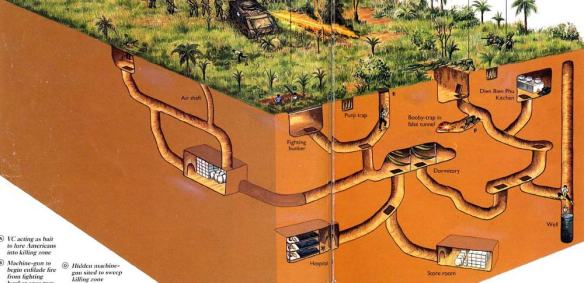
VIET CONG’S SECRET SUBTERRANEAN BASE VIETNAM, 1 NOVEMBER 1955 – 30 APRIL 1975
During the Vietnam War, the USA had the most advanced military in the world. Boasting technology and resources other nations could only dream of, their entrance to the conflict on the side of South Vietnam against the communist North Vietnam looked certain to turn the tide of the war.
But the Viet Cong, a guerrilla force on the side of the communists who were stationed in the South, had other ideas. Beneath the Cu Chi district near Saigon (now Ho Chi Minh City), communist forces had been digging tunnels here and there since the 1940s during their war of independence with the French. By the Sixties, however, this tunnel network spanned 250 kilometres (155 miles).
The Americans had expected a war above ground, but what they found instead was a determined Viet Cong force that, despite the Americans’ military superiority, were able to use their subsurface tunnel network to great advantage. They caused huge casualties, and were partly responsible for the US withdrawal in 1973.
These small, narrow tunnels – big enough for the smaller Viet Cong troops but cramped for the larger American and Australian troops – were dug mostly using hand tools. Conditions inside them ranged from poor to terrible. They were dark and dangerous, riddled with ants, scorpions, poisonous centipedes and other deadly creatures.
Thousands of Viet Cong lived underground during the war, including civilians and children. They would eat, go to school and even get married underground, coming out only to tend their crops. The advanced network of tunnels had numerous features to ensure the long-term survival of their residents, including air vents and secret exits.
The Viet Cong used the tunnels to mount surprise attacks, often appearing out of nowhere through trapdoors and hidden entrances, and they were always quick to improvise too. For example, when the Americans started sending out sniffer dogs to find entrances to the tunnels, Viet Cong troops used uniforms from dead American soldiers to mask the smell and fool the dogs.
On January 7, 1966, units of the U. S. 1st Infantry Division and the 173rd Airborne Brigade discovered this extensive network. This initial contact provided only a glimpse of the problems that tunnel fortifications would pose for U. S. forces at Cu Chi and across Vietnam. When the 25th Infantry Division established its base camp at Cu Chi later that spring, it assumed the task of clearing the tunnels. For several weeks the rear areas of the division were attacked by VC soldiers emerging from the tunnels, a type of envelopment from below.
U. S. personnel attempted different approaches to clearing the tunnels. These included tear gas, acetylene gas, and explosives. Soon U. S. commanders realized that the only way to clear them effectively was by hand. This task fell to a group of volunteers who became known as “tunnel rats.” Because of the narrow tunnel passages, these men were almost uniformly small in stature and performed their duties with a minimum of equipment. Usually a tunnel rat went below with a pistol, a knife, and a flashlight. The tunnels proved to be physically and psychologically draining on American troops, and most tunnel rats served relatively short periods in this taxing assignment.
Tunnel networks were later discovered in other parts of Vietnam, but none were as extensive or as problematic as those at Cu Chi. By 1967 the tunnels had been cleared, but they served as an early example of the tactical ingenuity and tenacity facing U. S. forces in Vietnam. Today the Cu Chi tunnels are a major tourist attraction.